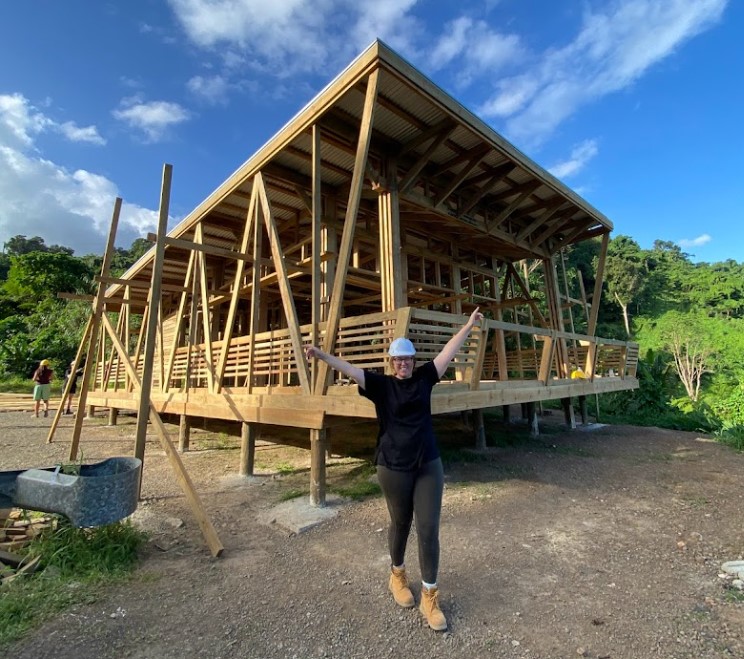In August 2022, I travelled to Fiji to help build a cafe run by the local community of Urata village. The eight-week project was split into two parts, and I joined on the second part. The cafe was funded by the Rotary Club of Savusavu, who received a Covid recovery fund from the US embassy. The aim was to bring the local community of Urata a beneficial source of income.
My temporary home was based in Urata, a village outside the town of Savusavu. It is located on the north island of Fiji called Vanua Levu. When we arrived, we had to accept an offering of Kava plant, which makes a traditional drink from its root. The village has around 70 houses and is split into three Mataqali, communities that own the land. Each community has its own building for their ceremonies. We stayed with the main Mataqali called Urata Mataqali.
The project was on top of the hill adjacent to the village and still part of the Mataqali. The view on site was over Urata Village and out towards Savusavu.
I was volunteering for CAUKIN Studio, who create impact through architecture around the world. CAUKIN was founded by a group of students during their studies at Cardiff University “on the premise that everybody should have access to better designed and built spaces”. The team consisted of five leaders and 14 volunteers. During the last four weeks of the project, all volunteers were from an architectural background. The participants were from around the world and the age ranges meant some were still at university to some working in practice.
With an increasing amount and severity of cyclones in the Pacific Islands, the impact on Fijian buildings, especially in rural areas, needs to be addressed. The current problem is that there is a variety of vernacular, some because of globalisation. A lack of building codes and education, poorly built and maintained buildings by communities, resulting in buildings vulnerable to destruction during cyclones, is what inspired me to take on this project. I have been interested in this topic during my studies and wanted to contribute towards more resilient communities.
During my Masters studies, I wrote my dissertation on Natural disaster and Fijian communities – An examination of potential strategies in the built environment. I was examining how the construction methods of cyclone resilience and community resilience can help to prevent destruction during ever-increasing cyclones and what can be done differently. In addition, as well as my colleague, I have had years of training of how a building is put together. This allowed us to quickly adapt to constructing the building without much training.
For this project, we used an engineer to help the building be as cyclone-resilient as possible. The structure of the building was carefully designed so it was braced and reinforced at weak points for the power of cyclones. Cyclone strapping was used to tie down the purlins to trusses and prevent uplift from the strong winds. Sheet glass was avoided where possible, as this is more likely to shatter in a cyclone. Instead, louvred windows were used with individual planes of glass where, if one shatters, it is easier and cheaper to replace.
The main material used for this project was treated timber. This is due to the ease of handling of the material in construction. This construction technique is easier to replicate by the locals so that they can transfer their own knowledge for future buildings. Timber is also readily available in Fiji and has been used since the use of traditional vernacular architecture. The roof was constructed from corrugated metal for waterproofing purposes. Again, this is a readily available material.
Compared to somewhere temperate like the UK or western Europe, where violent storms are rare, there is a lot more consideration on Cyclone resilience. There is cyclone strapping and louvred windows instead of sheet glazing in the windows. The building is lifted off the ground. There is a heavy use of timber, not masonry, due to availability and the wide use of timber in Fiji. Although there is no building control, we tried to keep it to British regulations.
For this kind of work, we needed to consider how much material to order so that there isn’t wastage after the build or a shortage of material. Another consideration is planning the work. This is important due to a very tight timeframe of eight weeks. They had to consider where the material and all the equipment is stored to ensure safety. Transporting the materials up to site was also a consideration where a truck had to be ordered.
The project in this climate was certainly much harder than I thought but, at the same time, much more rewarding than expected. We were in quite a rainy part of Fiji with unpredictable weather. At times, we were unsure how long the rain would last, which was a challenge until the roof was installed. However, the community was very welcoming and friendly. They made us feel at home.
The biggest challenge was the time limit. With an eight-week project, there was a lot to complete within the timeframe. Although everything was planned each day, there were still problems that arose. In addition, whilst we were getting used to the work, the process was a bit slower. The leaders were staying for an extra week in case the work was not completed, but that is all that was available. We managed to complete the majority of the work with the final tasks completed over the last few days. Another challenge was the use of the timber available. We had a timber order to cover the whole building. As we were new to using the tools, we had to make sure the cut was as accurate as possible without wasting material. Not all the timber was in good condition either, which made it more important to be accurate. In the end, we managed to complete the building without additional timber orders.
The idea of this project was a building to aid the community. The aim was to engage with the local community and to help them understand better cyclone resistant buildings. By involving them with the project, they can transfer the skills make their own buildings more resilient to cyclones. Engaging the local community will also encourage women to build. With many women participating in the project, including Fijian women, it can show the community this is achievable. We had lots of Fijians helping on site, which was great for everyone to share skills and learn from each other.
I have learnt many new skills during this project which will carry forward with my career in architecture. Firstly, how to use equipment that I have not used before and how to construct a building. I became aware that sometimes the design and construction needs adjustment for construction ease. It is much more difficult to accurately construct than I thought it would be.
Spending some time living with the community also taught me the Fijian culture and let me experience the local cuisine. As well as giving me valuable architectural experience, the trip showed me how kind and welcoming Fijians are and the level of respect they have.


